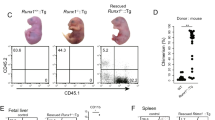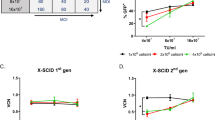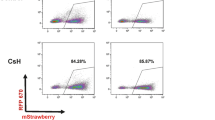Abstract
In utero cell and gene therapies constitute alternative strategies to the postnatal treatment of inherited diseases. Fetal hematopoietic progenitors could be a potential source of donor cells for these strategies. In this study, hematopoietic lineage-negative fetal liver cells from 14.5-day-old fetuses were transduced under different cytokine and culture combinations using a lentiviral vector expressing the enhanced green fluorescent protein (EGFP). When cells were transduced for 6 h in the presence of mSCF, hTPO and FLT3-L in retronectin-coated dishes at a multiplicity of infection of 10 transduction units/cell, up to 70% of granulo–macrophage colony-forming cells expressed the EGFP reporter gene. In utero transplantation experiments revealed that conditions leading to high transduction efficiencies were associated with poor engraftments of syngeneic recipients. Significantly, this effect was associated with the detection of a humoral and cellular immunoresponse against the transgenic protein. Moreover, the humoral response against EGFP was detected not only in in utero transplanted recipients but also in the operated mothers, suggesting the maternal origin of the anti-EGFP immunoresponse. These observations reinforce the necessity of carefully studying the potential immunoresponses in future prenatal gene therapy protocols.
This is a preview of subscription content, access via your institution
Access options
Subscribe to this journal
Receive 12 print issues and online access
$259.00 per year
only $21.58 per issue
Buy this article
- Purchase on Springer Link
- Instant access to full article PDF
Prices may be subject to local taxes which are calculated during checkout







Similar content being viewed by others
References
Flake AW . In utero stem cell transplantation. Best Pract Res Clin Obstet Gynaecol 2004; 18: 941–958.
Surbek D, Schoeberlein A, Wagner A . Perinatal stem-cell and gene therapy for hemoglobinopathies. Semin Fetal Neonatal Med 2008; 13: 282–290.
Coutelle C, Douar AM, Colledge WH, Froster U . The challenge of fetal gene therapy. Nat Med 1995; 1: 864–866.
Waddington SN, Kramer MG, Hernandez-Alcoceba R, Buckley SM, Themis M, Coutelle C et al. In utero gene therapy: current challenges and perspectives. Mol Ther 2005; 11: 661–676.
Alfirevic Z, von Dadelszen P . Instruments for chorionic villus sampling for prenatal diagnosis. Cochrane Database Syst Rev 2003: CD000114.
Hayashi S, Flake AW . In utero hematopoietic stem cell therapy. Yonsei Med J 2001; 42: 615–629.
Rio P, Martinez-Palacio J, Ramirez A, Bueren JA, Segovia JC . Efficient engraftment of in utero transplanted mice with retrovirally transduced hematopoietic stem cells. Gene Therapy 2005; 12: 358–363.
Muench MO . In utero transplantation: baby steps towards an effective therapy. Bone Marrow Transplant 2005; 35: 537–547.
Merianos D, Heaton T, Flake AW . In utero hematopoietic stem cell transplantation: progress toward clinical application. Biol Blood Marrow Transplant 2008; 14: 729–740.
Peranteau WH, Endo M, Adibe OO, Flake AW . Evidence for an immune barrier after in utero hematopoietic-cell transplantation. Blood 2007; 109: 1331–1333.
Bigger BW, Siapati EK, Mistry A, Waddington SN, Nivsarkar MS, Jacobs L et al. Permanent partial phenotypic correction and tolerance in a mouse model of hemophilia B by stem cell gene delivery of human factor IX. Gene Therapy 2006; 13: 117–126.
Kim I, Yilmaz OH, Morrison SJ . CD144 (VE-cadherin) is transiently expressed by fetal liver hematopoietic stem cells. Blood 2005; 106: 903–905.
Bowie MB, McKnight KD, Kent DG, McCaffrey L, Hoodless PA, Eaves CJ . Hematopoietic stem cells proliferate until after birth and show a reversible phase-specific engraftment defect. J Clin Invest 2006; 116: 2808–2816.
Nygren JM, Bryder D, Jacobsen SE . Prolonged cell cycle transit is a defining and developmentally conserved hemopoietic stem cell property. J Immunol 2006; 177: 201–208.
Kim I, Saunders TL, Morrison SJ . Sox17 dependence distinguishes the transcriptional regulation of fetal from adult hematopoietic stem cells. Cell 2007; 130: 470–483.
Johansson MK, de Vries TJ, Schoenmaker T, Ehinger M, Brun AC, Fasth A et al. Hematopoietic stem cell-targeted neonatal gene therapy reverses lethally progressive osteopetrosis in oc/oc mice. Blood 2007; 109: 5178–5185.
Rebel VI, Miller CL, Eaves CJ, Lansdorp PM . The repopulation potential of fetal liver hematopoietic stem cells in mice exceeds that of their liver adult bone marrow counterparts. Blood 1996; 87: 3500–3507.
Hanenberg H, Xiao XL, Dilloo D, Hashino K, Kato I, Williams DA . Colocalization of retrovirus and target cells on specific fibronectin fragments increases genetic transduction of mammalian cells. Nat Med 1996; 2: 876–882.
Donahue RE, Sorrentino BP, Hawley RG, An DS, Chen IS, Wersto RP . Fibronectin fragment CH-296 inhibits apoptosis and enhances ex vivo gene transfer by murine retrovirus and human lentivirus vectors independent of viral tropism in nonhuman primate CD34+ cells. Mol Ther 2001; 3: 359–367.
Miller CL, Eaves CJ . Expansion in vitro of adult murine hematopoietic stem cells with transplantable lympho-myeloid reconstituting ability. Proc Natl Acad Sci USA 1997; 94: 13648–13653.
Albella B, Segovia JC, Guenechea G, Pragnell IB, Bueren JA . Preserved long-term repopulation and differentiation properties of hematopoietic grafts subjected to ex vivo expansion with stem cell factor and interleukin 11. Transplantation 1999; 67: 1348–1357.
Bowie MB, Kent DG, Copley MR, Eaves CJ . Steel factor responsiveness regulates the high self-renewal phenotype of fetal hematopoietic stem cells. Blood 2007; 109: 5043–5048.
Li K, Chuen CK, Lee SM, Law P, Fok TF, Ng PC et al. Small peptide analogue of SDF-1alpha supports survival of cord blood CD34+ cells in synergy with other cytokines and enhances their ex vivo expansion and engraftment into nonobese diabetic/severe combined immunodeficient mice. Stem Cells 2006; 24: 55–64.
Lam AC, Li K, Zhang XB, Li CK, Fok TF, Chang AM et al. Preclinical ex vivo expansion of cord blood hematopoietic stem and progenitor cells: duration of culture; the media, serum supplements, and growth factors used; and engraftment in NOD/SCID mice. Transfusion 2001; 41: 1567–1576.
Hayashi S, Hsieh M, Peranteau WH, Ashizuka S, Flake AW . Complete allogeneic hematopoietic chimerism achieved by in utero hematopoietic cell transplantation and cotransplantation of LLME-treated, MHC-sensitized donor lymphocytes. Exp Hematol 2004; 32: 290–299.
Renda MC, Fecarotta E, Dieli F, Markling L, Westgren M, Damiani G et al. Evidence of alloreactive T lymphocytes in fetal liver: implications for fetal hematopoietic stem cell transplantation. Bone Marrow Transplant 2000; 25: 135–141.
Toivanen P, Uksila J, Leino A, Lassila O, Hirvonen T, Ruuskanen O . Development of mitogen responding T cells and natural killer cells in the human fetus. Immunol Rev 1981; 57: 89–105.
Lindton B, Markling L, Ringden O, Kjaeldgaard A, Gustafson O, Westgren M . Mixed lymphocyte culture of human fetal liver cells. Fetal Diagn Ther 2000; 15: 71–78.
Lindton B, Markling L, Ringden O, Westgren M . In vitro studies of the role of CD3+ and CD56+ cells in fetal liver cell alloreactivity. Transplantation 2003; 76: 204–209.
Westgren M, Ringden O, Eik-Nes S, Ek S, Anvret M, Brubakk AM et al. Lack of evidence of permanent engraftment after in utero fetal stem cell transplantation in congenital hemoglobinopathies. Transplantation 1996; 61: 1176–1179.
Orlandi F, Giambona A, Messana F, Marino M, Abate I, Calzolari R et al. Evidence of induced non-tolerance in HLA-identical twins with hemoglobinopathy after in utero fetal transplantation. Bone Marrow Transplant 1996; 18: 637–639.
Merianos DJ, Tiblad E, Santore MT, Todorow CA, Laje P, Endo M et al. Maternal alloantibodies induce a postnatal immune response that limits engraftment following in utero hematopoietic cell transplantation in mice. J Clin Invest 2009; 119: 2590–2600.
Puig T, Kadar E, Limon A, Cancelas JA, Eixarch H, Luquin L et al. Myeloablation enhances engraftment of transduced murine hematopoietic cells, but does not influence long-term expression of the transgene. Gene Therapy 2002; 9: 1472–1479.
Rosenzweig M, MacVittie TJ, Harper D, Hempel D, Glickman RL, Johnson RP et al. Efficient and durable gene marking of hematopoietic progenitor cells in nonhuman primates after nonablative conditioning. Blood 1999; 94: 2271–2286.
Kang E, Giri N, Wu T, Sellers S, Kirby M, Hanazono Y et al. In vivo persistence of retrovirally transduced murine long-term repopulating cells is not limited by expression of foreign gene products in the fully or minimally myeloablated setting. Hum Gene Ther 2001; 12: 1663–1672.
Lutzko C, Omori F, Abrams-Ogg AC, Shull R, Li L, Lau K et al. Gene therapy for canine alpha-L-iduronidase deficiency: in utero adoptive transfer of genetically corrected hematopoietic progenitors results in engraftment but not amelioration of disease. Hum Gene Ther 1999; 10: 1521–1532.
Carter RF, Abrams-Ogg AC, Dick JE, Kruth SA, Valli VE, Kamel-Reid S et al. Autologous transplantation of canine long-term marrow culture cells genetically marked by retroviral vectors. Blood 1992; 79: 356–364.
Kantoff PW, Flake AW, Eglitis MA, Scharf S, Bond S, Gilboa E et al. In utero gene transfer and expression: a sheep transplantation model. Blood 1989; 73: 1066–1073.
Chan J, Waddington SN, O’Donoghue K, Kurata H, Guillot PV, Gotherstrom C et al. Widespread distribution and muscle differentiation of human fetal mesenchymal stem cells after intrauterine transplantation in dystrophic mdx mouse. Stem Cells 2007; 25: 875–884.
Guillot PV, Abass O, Bassett JH, Shefelbine SJ, Bou-Gharios G, Chan J et al. Intrauterine transplantation of human fetal mesenchymal stem cells from first-trimester blood repairs bone and reduces fractures in osteogenesis imperfecta mice. Blood 2008; 111: 1717–1725.
Carrier E, Lee TH, Busch MP, Cowan MJ . Induction of tolerance in nondefective mice after in utero transplantation of major histocompatibility complex-mismatched fetal hematopoietic stem cells. Blood 1995; 86: 4681–4690.
Hayashi S, Peranteau WH, Shaaban AF, Flake AW . Complete allogeneic hematopoietic chimerism achieved by a combined strategy of in utero hematopoietic stem cell transplantation and postnatal donor lymphocyte infusion. Blood 2002; 100: 804–812.
Peranteau WH, Hayashi S, Hsieh M, Shaaban AF, Flake AW . High-level allogeneic chimerism achieved by prenatal tolerance induction and postnatal nonmyeloablative bone marrow transplantation. Blood 2002; 100: 2225–2234.
Almarza E, Rio P, Meza NW, Aldea M, Agirre X, Guenechea G et al. Characteristics of lentiviral vectors harboring the proximal promoter of the vav proto-oncogene: a weak and efficient promoter for gene therapy. Mol Ther 2007; 15: 1487–1494.
Graham FL, van der Eb AJ . Transformation of rat cells by DNA of human adenovirus 5. Virology 1973; 54: 536–539.
Bacchetti S, Graham FL . Transfer of the gene for thymidine kinase to thymidine kinase-deficient human cells by purified herpes simplex viral DNA. Proc Natl Acad Sci USA 1977; 74: 1590–1594.
Acknowledgements
The authors thank A de la Cal, S Losada, S Moreno and A Azevedo for their technical assistance; S García for irradiating the animals; and I Orman for his expert help with the flow cytometry procedures. This work was funded by grants from the Ministerio de Educación y Ciencia (SAF2008–1883), Fondo de Investigaciones Sanitarias (RD06/0010/0015) and the PERSIST European project (FP7). The authors also acknowledge the Fundación Marcelino Botín for promoting translational research at the Hematopoiesis and Gene Therapy Division-CIEMAT/CIBERER.
Author information
Authors and Affiliations
Corresponding author
Ethics declarations
Competing interests
The authors declare no conflict of interest.
Additional information
Supplementary Information accompanies the paper on Gene Therapy website
Rights and permissions
About this article
Cite this article
Alonso-Ferrero, M., Valeri, A., Yañez, R. et al. Immunoresponse against the transgene limits hematopoietic engraftment of mice transplanted in utero with virally transduced fetal liver. Gene Ther 18, 469–478 (2011). https://doi.org/10.1038/gt.2010.160
Received:
Revised:
Accepted:
Published:
Issue Date:
DOI: https://doi.org/10.1038/gt.2010.160



